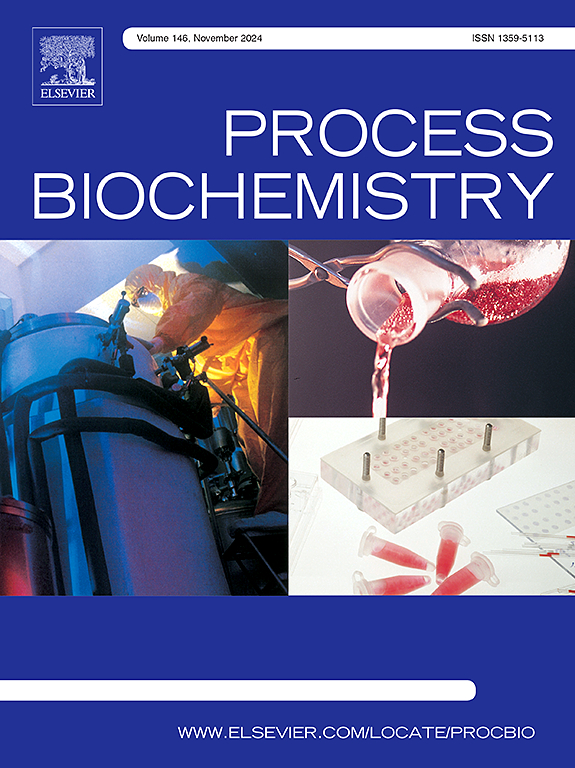Efficient degradation of azo dyes by an engineered myoglobin with a modified heme active site showing high peroxidase activity
IF 4
3区 生物学
Q2 BIOCHEMISTRY & MOLECULAR BIOLOGY
引用次数: 0
Abstract
Azo dyes, widely used in global textiles, persist in wastewater causing significant ecological and health risks, necessitating efficient degradation to protect ecosystems and public health. The development of artificial metalloenzymes has provided advanced biotechnological solutions to address this challenge. This study presents a highly efficient artificial metalloenzyme, F43Y/H64D myoglobin (F43Y/H64D Mb), engineered from sperm whale myoglobin with a modified heme active site by replacement of Phe43 with Tyr and His64 with Asp, respectively, for azo dye degradation. The engineered enzyme achieved degradation efficiencies of approximately 93 %, 93 %, and 90 % for Acid Orange 7, Methyl Orange, and Acid Blue 92, respectively, within 10 seconds. Its overall catalytic efficiency was found to be approximately 3.6 times higher than that of horseradish peroxidase, a widely used natural enzyme. HPLC and ESI-MS analyses proposed degradation pathways, and bacterial toxicity tests confirmed reduced toxicity post-degradation. Furthermore, F43Y/H64D Mb exhibited excellent performance in natural aquatic environments, surpassing many recently reported results in efficiency, reaction speed, and operational simplicity. These findings highlight the feasibility of F43Y/H64D Mb for efficient azo dye decolorization and degradation in wastewater, offering a novel enzymatic tool for sustainable environmental remediation.
具有高过氧化物酶活性的修饰血红素活性位点的工程肌红蛋白有效降解偶氮染料
偶氮染料在全球纺织品中广泛使用,在废水中持续存在,造成重大的生态和健康风险,需要有效降解以保护生态系统和公众健康。人工金属酶的发展为解决这一挑战提供了先进的生物技术解决方案。本研究以抹香鲸肌红蛋白为原料,分别用Tyr代替Phe43和Asp代替His64修饰血红素活性位点,构建了一种高效的人造金属酶F43Y/H64D肌红蛋白(F43Y/H64D Mb),用于偶氮染料的降解。该工程酶在10 秒内对酸性橙7、甲基橙和酸性蓝92的降解效率分别达到约93 %、93 %和90 %。其总体催化效率比广泛使用的天然酶辣根过氧化物酶高约3.6倍。HPLC和ESI-MS分析提出了降解途径,细菌毒性试验证实降解后毒性降低。此外,F43Y/H64D Mb在自然水生环境中表现出优异的性能,在效率、反应速度和操作简单性方面超过了许多最近报道的结果。这些研究结果突出了F43Y/H64D Mb对偶氮染料废水进行高效脱色和降解的可行性,为可持续环境修复提供了一种新的酶促工具。
本文章由计算机程序翻译,如有差异,请以英文原文为准。
求助全文
约1分钟内获得全文
求助全文
来源期刊

Process Biochemistry
生物-工程:化工
CiteScore
8.30
自引率
4.50%
发文量
374
审稿时长
53 days
期刊介绍:
Process Biochemistry is an application-orientated research journal devoted to reporting advances with originality and novelty, in the science and technology of the processes involving bioactive molecules and living organisms. These processes concern the production of useful metabolites or materials, or the removal of toxic compounds using tools and methods of current biology and engineering. Its main areas of interest include novel bioprocesses and enabling technologies (such as nanobiotechnology, tissue engineering, directed evolution, metabolic engineering, systems biology, and synthetic biology) applicable in food (nutraceutical), healthcare (medical, pharmaceutical, cosmetic), energy (biofuels), environmental, and biorefinery industries and their underlying biological and engineering principles.
 求助内容:
求助内容: 应助结果提醒方式:
应助结果提醒方式:


